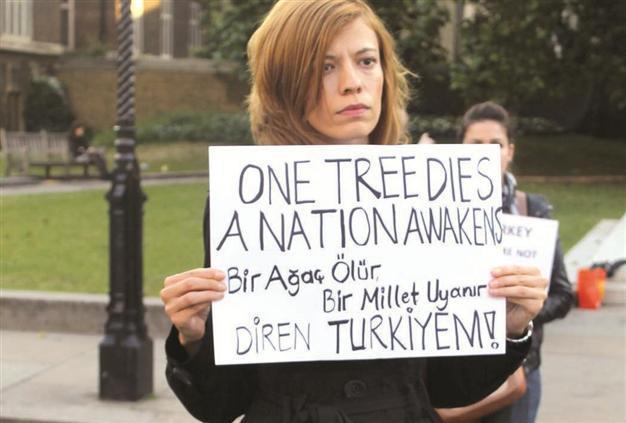Performance art becomes a vehicle for protest
ISTANBUL - Hürriyet Daily News
 Turkey’s Gezi protests provided fertile ground for the use of “disproportionate intellect” as demonstrators deployed humor and art to present their case against the government. While the graffiti around Taksim showed remarkable ingenuity, the use of art was not just limited to the non-kinetic variety; performance art also put its stamp on the protests, particularly with Erdem Gündüz’s “standing man” demonstration.
Turkey’s Gezi protests provided fertile ground for the use of “disproportionate intellect” as demonstrators deployed humor and art to present their case against the government. While the graffiti around Taksim showed remarkable ingenuity, the use of art was not just limited to the non-kinetic variety; performance art also put its stamp on the protests, particularly with Erdem Gündüz’s “standing man” demonstration.Gündüz, himself a performance artist, touched off a nationwide phenomenon after he stood still for eight hours in Taksim Square on June 17, two days after police violently ejected hundreds of peace protesters from Gezi Park. Gündüz inspired hundreds to also stand still in the square, while his demonstration was imitated across the country.
Gündüz’s performance art-inspired act of civil disobedience quickly became dubbed the “standing man” (duran adam) on social media.
Protesting events via performance art has become one of the new faces of the art. Most recently, rapper Mos Def has attracted attention to Washington’s continued use of Guantanamo Bay to incarcerate terrorism suspects by staging a video depicting himself struggling and weeping while undergoing the procedures.

Last year during International Performance Association
Festival in Istanbul the participants gathered in Taksim
with empty banners and walked, which is a part of
performance art act.
Mos Def, also known as Yasiin Bey, released the video on the first day of Ramadan. New Yorker magazine reported: “The video released by a London-based human-rights group called Reprieve, directed by Asif Kapadia, in which the musician and actor Yasiin Bey, formerly known as Mos Def, undergoes nose-to-stomach force-feeding according to military instructions that Al Jazeera leaked in May. The video, nearly five minutes long, is extremely uncomfortable to watch: Bey is shackled to a chair while a tube is forced down his throat by a medical attendant, all according to “standard operating procedure.”
Many people were unclear as to the reasons behind the recording artist’s decision to submit to the procedure. The same article in the New Yorker said: “Why should a popular musician take this upon himself? Isn’t this video just another publicity stunt? Or is it a legitimate form of performance art? An avant-garde artist like Marina Abramovic, who cuts or whips or starves herself during performances, is accorded the respect of a MOMA retrospective. So why shouldn’t a commercial performing artist like Bey be applauded for having the courage to put his body through similar rigors in view of the public?”
The fact is that Mos Def has raised attention to an issue that many people are not familiar with. Seeing Mos Def crying, weeping and experiencing severe discomfort, forces people to think about the abuse that people are subjected to at Guantanamo.
This in some sense may be referred to as a performance art. If the aim of the video is to raise awareness about the events that are occurring at Guantanamo, Mos Def does it in a very careful way.
The New Yorker, however, also noted the potential upsides for Mos Def’s continued commercial success.
“Surely this video will help Bey’s album, folio, or film sales; he and his public-relations team realize that the exposure will promote his brand. But he deserves our admiration nonetheless for using his influence in the service of righteous protest. The video, released on a scorching July day, a particularly difficult one for fasting, brought to mind Rebecca Mead’s verdict on Angelina Jolie’s recent decision to make public her preventive double-mastectomy surgery: ‘It is what celebrity is for.’”
Protesting in Gezi Park
When looking around the world, Mos Def is not the only one to use performance art for a larger cause. The Gezi Park protests witnessed two main performance art protests, the standing man of Gürbüz and a woman who sang in a bikini in the middle of the Taksim square to protest the government.
Mine Dost appeared only in bikini and running shoes while protesters were standing silently or reading. While many people said her act was just a show, once again just like Mos Def or Gürbüz, she attracted attention and said what she wanted to say by dancing. However, her act failed to catch on as a movement to protest via performance art.
“It is very natural that performance has an oppositional approach,” Burçak Konukman, the International Performance Festival’s (IPA) Istanbul director, told the Hürriyet Daily News about performance art. “On the other hand, we don’t always see this. However, an artist uses his or her body in general as a way to stand against the authorities.”
Recalling similar acts from the IPA festival last year in Istanbul, Konukman noted that artist Roi Vaara, who was wearing a suit, held a banner aloft saying “Follow me” and started to march on Taksim, proceeding very slowly without saying anything. People approached to ask if Vaara was making a protest, only to be told that the main goal was just to raise attention.
“The venue is a symbol, and Vaara was referring to the venue [in terms of its connection to protests] but at the same time, he was raising attention just like a protestor,” Konukman said.
It is evident that the notion of performance art has “irony” and “humor” and is not just about protesting, according to Konukman. Still, protesting via art is a way to raise one’s voice to reach an audience that might not otherwise have taken notice.
















